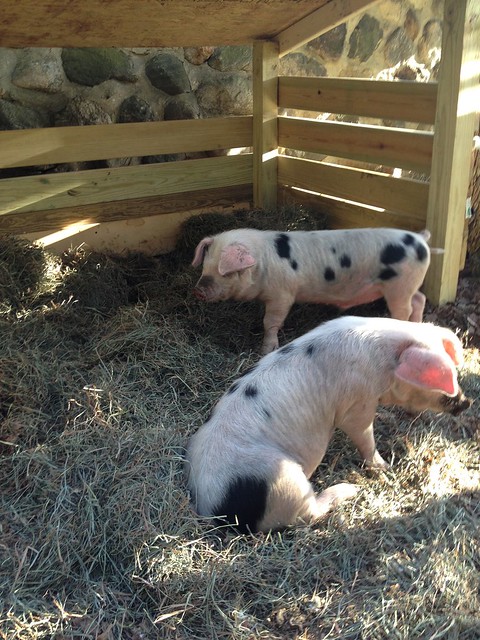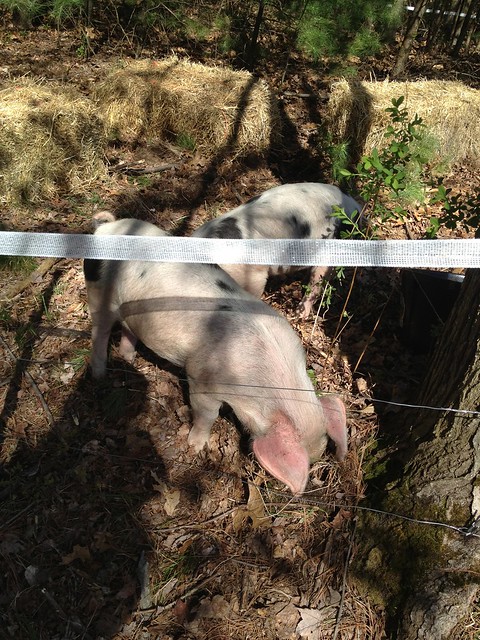They're getting bigger and multiplying
/Chorizo & Honeydew - our two Gloucester Old Spot piglets - are not such piglets any more. They're three months old, and on a diet of grain, peanuts and forage.
They've been with us a couple of weeks now, and I swear you can almost watch them grow. They arrived weighing maybe a bit over 35 pounds apiece, and have got to be approaching 50 now.

It took a little bit of work, and a couple of escapes, but I think I figured out the electric fence. Fortunately for me, 1) the pigs will follow me anywhere if I'm carrying a bucket of raw peanuts, and 2) the electric fence hurts like hell, but doesn't seem to do any permanent damage when I shock myself.
(The secret is in having sufficient ground. The first ground rod I put in was a 4 ft length of re-bar that I happened to have plenty of from our annual pig roast set-up. That was not nearly enough to produce more than a little tingle. So I went and bought an 8 ft. copper ground rod to pound into the soil.
There's a story my step-father, the Carpenter, told me once, about working with his father to build some fishing cabins up in the woodsy wilderness of Northwest Ontario. His father produced a similar giant copper cylinder, and pointed up a ladder. "Beat this into the ground, boy." And my step-father climbed up to the upper rungs with a sledge hammer to beat the thing down far enough to get sufficient ground for the circuit.
Eventually it dawned on him. The rules don't say it has to be vertical.
I laughed when I pulled my own giant rod of copper out of the bed of my truck and went hunting for my hammer. If it hadn't been for him telling me that story, I would have been on the roof of my barn, trying to get sufficient leverage to pound that thing down far enough to wrap my ground wire around it. Instead, I stood safely on the dirt, angled the rod low enough to get a good whack at it, and knocked it in diagonally, and perfectly adequate to provide the ground connection I needed).
Chorizo and Honeydew learned pretty quickly that the fence was no longer just a mild tingle, and was to be avoided. I admit that I learned the hard way to avoid accidental brushes with the fence as well.

Ever since we did battle with the neighborhood weasel, I had been thinking that we needed to bring in a few new pullets. I had been hopeful that we wouldn't have to get more chicks this year - we had 24 birds, most of which were still in their 2nd or early 3rd year, and productive enough. But the weasel had cut the population in half in the weeks before we trapped and killed him. But with the pigs, I just hadn't felt like dealing with the additional effort that baby chicks requires. Brooder. Hardening off. Integrating with an existing flock. Meh. I just wasn't really looking forward to telling my daughter (the Critter, as we still call her around here), that she was going to be a little low on eggs to sell this year.
So I had sort of half-heartedly begun thinking about pullets. A couple of times, I've been able to find somone who had young pre-lay hens in the area. The biggest drawback being that you usually end up with a very limited breed selection. But that's how I got our first batch of Araucanas (which lay the easter-egg pale blue or green eggs).
Then, by a stroke of luck, our good friend and nearby neighbor, Terry (of Hencam.com) was ready to sell a dozen of her new young pullets. She had been engaged to find and ready a few hens for an area nursing home, and added on some other hens both to supplement her own flock, and ensure she got a good variety to choose from. That left her with an extra dozen - which was truly serendipitous.
Terry and her husband were the just about the first peopple I met when I moved to the area, and I knew that she chose birds for variety, health and interest, and that she takes terrific care of all of her animals.
And as you can see - these young lady hens are gentle and curious, and have settled in to their new homes quite well.

At this point, we've got the flock integration routine down to a pretty good routine, with a segregated run and temporary shelters. Over the next ten days or so, the two flocks of older and younger birds will live side by side, and get used to interacting through the fence. I'll keep the older hens active and interested with cabbage, bugs and lawn clippings, to give them plenty of reason to be content despite these new young interlopers in their space.
And by the end of summer, we'll be back up to the regular production levels to keep the Critter's egg business going.










